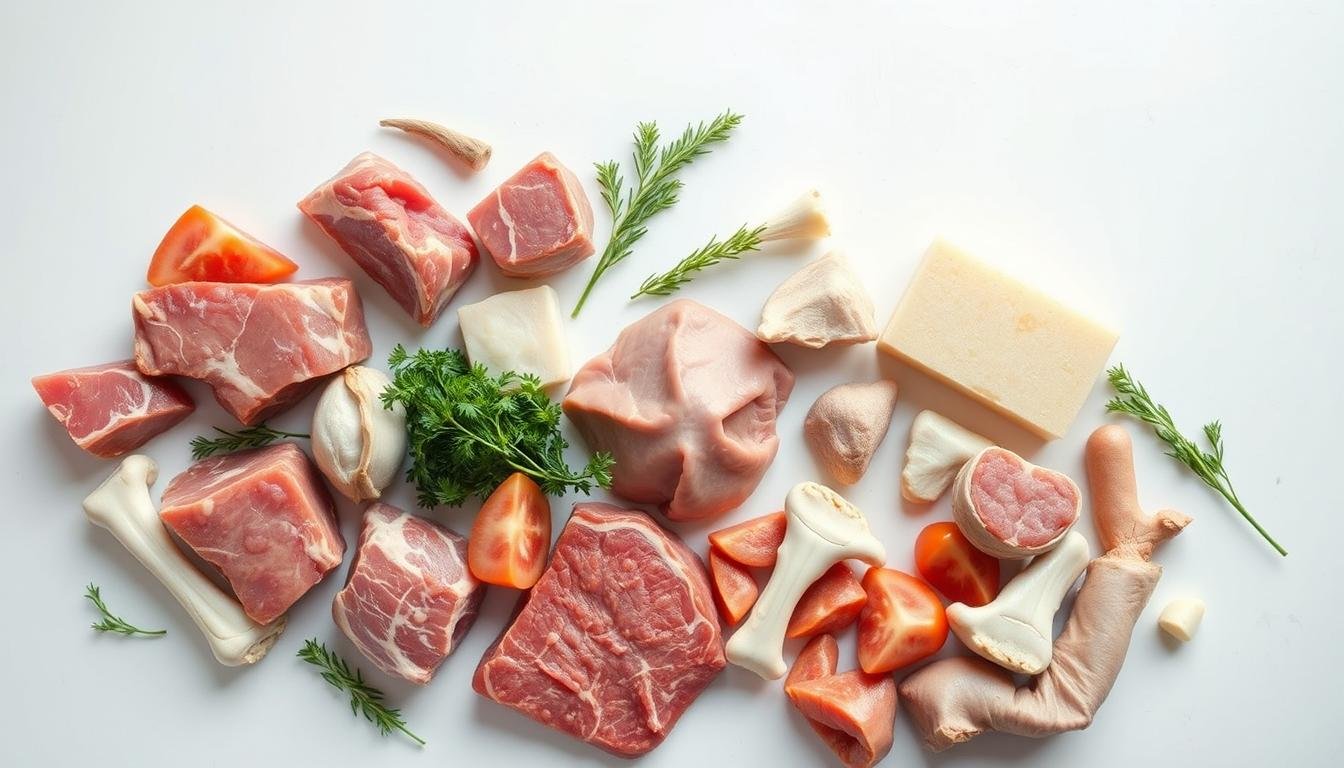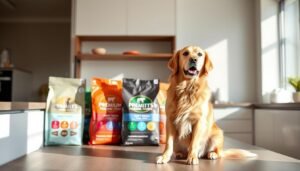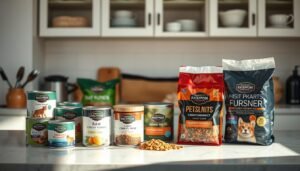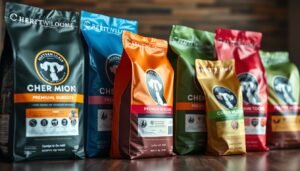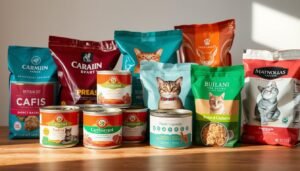Last summer, I was in a pet food aisle. There were many colorful bags and labels that said “vitality” and “all-natural”. My golden retriever, Bella, had dull fur and low energy. I thought maybe her kibble was bad for her.
After researching, I found raw pet food. It seemed fresh and full of nutrients. But, I learned it’s more than just a new food. It’s about knowing how to handle it and what your pet needs.
Choosing the right food for your pet is very important. More pet owners are looking for better food than kibble. Raw pet food is becoming popular. It’s not just for quick fixes; it’s for long-term health.
Let’s look at what you need to know before switching.
Key Takeaways
- Raw pet food can provide a more natural diet for better nutrition.
- Transitioning requires careful planning and consideration of your pet’s needs.
- Understanding the basics is critical to ensure pet health and safety.
- Researching the types of raw pet food available helps in making informed choices.
- A raw diet may improve your pet’s coat, energy levels, and digestive health.
- Every pet is unique; adjustments may be necessary when switching diets.
Understanding Raw Pet Food Basics
Many pet owners wonder, “what is raw pet food?” It’s a diet that tries to match what pets would eat in the wild. It includes raw meats, bones, fruits, and veggies. Knowing about raw feeding is key to giving pets the best nutrition.
What is Raw Pet Food?
Raw pet food is made from uncooked ingredients. It’s meant to be like what pets would eat naturally. Many believe it makes pets healthier, thanks to natural pet food.
It’s thought to be closer to what dogs and cats ate long ago.
Types of Raw Pet Food Available
There are different types of raw pet food to pick from. Here are two main kinds:
- Balanced Raw Diet: This mix includes various meats, bones, and organs. It’s designed to be complete nutritionally. It uses different animal parts for all needed nutrients.
- Prey Model Raw (PMR): This type tries to mimic what pets would hunt. It often gives whole prey or specific parts. It’s based on how pets naturally eat.
Benefits of Feeding Raw Pet Food
Switching to raw pet food can make your furry friend healthier. It uses natural ingredients. Many pets get better coats, more energy, and better digestion.
Improved Coat and Skin Health
Raw pet food makes fur shinier and skin healthier. Pets eat better protein and fats. This makes their coats look great.
Increased Energy Levels
Pets get more energetic on a raw diet. They don’t eat fillers and additives. This means they’re more lively and fun to play with.
Better Digestive Health
Raw pet food helps with digestion. Pets have cleaner, smaller stools. Fresh meats and enzymes help them digest better.
| Benefit | Description |
|---|---|
| Coat and Skin Health | Shinier fur and fewer skin allergies due to quality protein and healthy fats. |
| Energy Levels | Higher vitality and stamina resulting from better nutrient absorption. |
| Digestive Health | Improved digestion indicated by cleaner, smaller stools and optimal nutrient absorption. |
Potential Risks of Raw Pet Food
Thinking about switching to raw pet food? It’s key to know the risks. The excitement of raw feeding might hide dangers like nutritional imbalance and bacterial contamination. Knowing these helps keep pets safe.
Nutritional Imbalance Dangers
Raw pet food can lead to nutritional imbalance. If I only use one protein, my pet might miss important nutrients. A balanced diet is vital to avoid health problems from a lack of variety.
Bacterial Contamination Risks
Bacterial contamination is a big worry. Raw meats can have Salmonella and E. coli, harming pets and people. To stay safe, I must buy from trusted suppliers and handle food carefully.
Choosing the Right Raw Pet Food
Finding the right raw pet food can be tough. But, focusing on important details makes it easier. Reading labels well is key. They should show the food’s quality and avoid bad stuff.
Choosing organic pet food can give you peace of mind. It’s about knowing what you feed your pets.
Read Labels Carefully
It’s important to understand what’s in your pet’s food. Look for:
- High-quality, identifiable meat sources
- Absence of fillers or artificial additives
- Clear nutritional breakdown of vitamins and minerals
I look for quality in raw pet food. Organic options are often my first choice.
Consider Your Pet’s Diet History
My pet’s diet history matters a lot. Pets moving to raw food may need special care. Knowing their past helps tailor their diet for health.
Raw pet food delivery helps a lot. It lets me pick meals that fit my pets’ needs.
Making the Transition
Switching to raw pet food is good for pets and their owners. Start slow to help pets adjust. Watch how they react closely for the best results.
Gradual Introduction Tips
Begin with a little raw food mixed with their usual food. Do this for one to two weeks. It helps pets get used to the taste and texture.
It also helps avoid stomach problems. The goal is to find the right mix for your pet.
Monitoring Your Pet’s Reaction
Watching your pet closely is very important. Look for changes in their poop and energy. This shows how they’re doing with the new food.
Keeping an eye on their health helps make changes if needed. This makes the switch easier for them.
Common Myths About Raw Pet Food
When I started learning about raw pet food, I found many myths. It was important to know these myths to make good choices for my pets. Some think raw diets are not balanced, but they can be. Others worry about dangers in raw meat, but with care, these risks are low.
Learning the truth about raw diets helps pet owners make better choices. It’s about giving our pets the best food.
Myth: Raw Diets are Unbalanced
Many think raw diets are not good for pets. They believe they lack important nutrients. But, a well-made raw diet can give pets everything they need.
Talking to a vet or pet nutritionist can help. They can make sure the diet is balanced. This clears up worries about raw diets being bad.
Myth: Raw Meat is Always Dangerous
Some believe raw meat is always risky. They worry about germs like Salmonella or E. coli. But, with safe handling and the right meat, these risks can be small.
Choosing high-quality, safe ingredients makes pet owners feel better. It shows they care about their pets’ health.
| Myth | Reality |
|---|---|
| Raw diets are unbalanced | Can provide complete nutrition if well-formulated |
| Raw meat is always dangerous | Safe handling and sourcing can reduce risks |
Homemade vs. Commercial Raw Pet Food
Choosing between homemade and commercial raw pet food has its ups and downs. I’ve learned about the big differences in how they’re made, their nutrition, and safety.
Pros and Cons of Homemade Options
Homemade raw pet food lets you tailor meals to your pet’s needs. I like knowing what’s in their food, from proteins to veggies. But, making sure they get all the nutrients can be tricky.
Homemade food might seem cheaper at first, but making meals can take a lot of time. It’s also important to handle raw meats safely to avoid contamination.
Choosing Quality Commercial Brands
Commercial raw pet food is easier to use. It meets AAFCO standards, ensuring it’s balanced for pets. I look for brands with good sources and a variety of proteins.
Both homemade and commercial food have their benefits. Homemade is great for those who like to get involved. Commercial food is good for those who want convenience but fresh food.
Understanding these points helps me make better choices for my pets. I’ve also learned from research on raw diets.
Cost of Raw Pet Food
When I think about feeding my pet, the cost of raw food is important. Many think raw food costs more than kibble. But, with smart budgeting, the costs can go down. Learning about the fresh pet food market helps me plan better without hurting my pet’s health.
Is Raw Pet Food More Expensive?
At first, raw pet food might seem pricey. But, looking closer, the price gap isn’t always big. Prices change based on the protein, where it’s from, and the season. Thinking about long-term health can also help. A healthier pet might mean less vet visits, saving money in the long run.
Budget-Friendly Raw Feeding Tips
Raw diets don’t have to be expensive. Here are some tips I’ve found:
- Buying in bulk can lower the cost of raw pet food.
- Look for meat sales and buy seasonal foods to save money.
- Joining a co-op with other pet owners can help share costs.
- Using leftovers from my meals can cut down on waste and save money.
With smart planning, I can feed my pet raw food without breaking the bank. They get great nutrition and live a happier, healthier life.
Consulting with a Veterinarian
Getting advice from a vet is key before starting a raw diet for my pet. A vet can explain all about this big change. They know a lot about pet food and can help make changes for my pet’s needs.
Importance of Professional Guidance
Talking to a vet can prevent problems. They suggest the right proteins and supplements for my pet. They also think about my pet’s health, not just food.
Questions to Ask Your Vet
It’s good to ask a vet questions before starting a new diet. Here are some important ones:
- What types of proteins do you recommend for my pet?
- Are there specific supplements I should include in their diet?
- How should I transition my pet to a raw diet?
- What signs should I look for that could indicate a negative reaction to the new food?
- How often should I schedule follow-up consultations to monitor my pet’s health?
Ensuring Food Safety
Raw pet food needs to be safe for our pets and us. Bad handling and storage can harm both. Safe food handling and storage keep food fresh and safe.
Safe Food Handling Practices
Good food handling stops contamination. Here are key tips:
- Always wash hands before and after handling raw meats.
- Use separate cutting boards for raw pet food and human food.
- Clean all surfaces and utensils that touch raw food.
- Keep raw pet food refrigerated until it’s time to serve.
Storing Raw Pet Food
Good storage keeps food fresh and stops spoilage. Here are some ways:
- Use airtight containers for fridge or freezer storage.
- Label containers with the date to check freshness.
- Thaw frozen raw pet food in the fridge, not at room temperature.
- Don’t refreeze thawed raw meat; serve it in a few days.
Final Thoughts on Raw Pet Food
Choosing raw pet food means you must be very dedicated. You need to know if you can keep up with it for your pet’s whole life. For me, being consistent has helped a lot. It has made my pet healthier and happier.
Assessing Long-Term Commitment
Starting with raw pet food taught me a lot. It’s not just about changing their food. It’s about keeping up with it every day. Spending time on meals and finding good ingredients is key to my pet’s health.
My Personal Experience with Raw Feeding
Looking back, the benefits of raw feeding are clear. My pet’s shiny coat and energy are proof. It’s not easy, but seeing my pet happy makes it all worth it.

